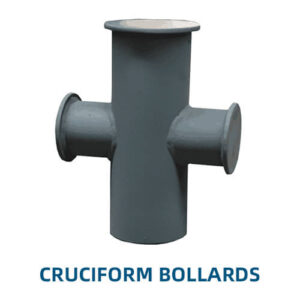Key Features of Open Roller Fairleads:
- Design and Construction:
- Rollers: Equipped with one or more cylindrical rollers that allow the line to roll smoothly as it passes through. This reduces friction and minimizes wear on both the line and the fairlead.
- Open Design: The fairlead has an open or U-shaped channel that allows easy access for lines to enter and exit. The open design ensures that lines can move freely without obstruction.
- Material: Typically made from durable materials such as stainless steel, aluminum, or high-strength alloys. These materials are chosen for their strength, corrosion resistance, and ability to withstand harsh marine conditions.
- Mounting: Mounted on docks, piers, ships, or other marine structures. The base is designed for secure attachment and stability, often bolted or welded in place.
- Types:
- Single Roller Fairlead: Features one roller that guides the line through a single channel. Suitable for applications with lighter loads or where minimal guidance is required.
- Multiple Roller Fairlead: Includes multiple rollers arranged in a row or pattern to accommodate larger or heavier lines and provide more effective guidance.
- Applications:
- Dock and Pier Mooring: Used to guide mooring lines during vessel docking and berthing. The rollers help manage line movement and reduce friction.
- Shipboard Operations: Installed on ships to manage lines such as anchor chains, mooring lines, and cargo handling ropes. The open roller design facilitates smooth operation and reduces wear.
- Marine and Offshore Platforms: Employed on floating platforms, oil rigs, and other offshore structures to guide and manage the movement of heavy cables and lines.
- Performance and Benefits:
- Reduced Friction: The rollers allow lines to roll smoothly, reducing friction and minimizing wear on both the fairlead and the lines.
- Ease of Use: The open design provides easy access for lines, making it simple to manage and adjust mooring operations.
- Durability: Built from robust materials designed to withstand marine environments, including exposure to saltwater, UV rays, and physical abrasion.
- Maintenance and Care:
- Inspection: Regularly inspect the open roller fairlead for signs of wear, corrosion, or damage. Check the rollers for smooth operation and proper alignment.
- Cleaning: Clean the fairlead to remove marine growth, debris, and contaminants. Use appropriate cleaning agents to avoid damage to the material.
- Lubrication: Ensure that the rollers are properly lubricated to maintain smooth operation and prevent seizing or binding.
- Safety Considerations:
- Load Capacity: Ensure the open roller fairlead is rated for the specific loads and types of lines it will handle. Overloading can cause damage or failure.
- Proper Installation: Ensure the fairlead is securely mounted and aligned to provide effective guidance and support for mooring lines.
- Line Management: Use appropriate line sizes and types for the fairlead to ensure proper fit and performance. Avoid overloading individual lines or components.
Advantages of Open Roller Fairleads:
- Smooth Operation: Rollers reduce friction and wear, providing a smoother operation for mooring lines and extending their lifespan.
- Ease of Access: The open design allows for easy entry and exit of lines, facilitating quick adjustments and management.
- Durability: Constructed from high-quality materials to handle heavy loads and withstand harsh marine conditions.
Considerations for Open Roller Fairleads:
- Selection: Choose the appropriate size, type, and number of rollers based on the specific mooring requirements and the type of lines being used.
- Maintenance: Regularly inspect and maintain the fairlead, including lubricating the rollers, to ensure continued functionality and safety.
- Compliance: Follow relevant industry standards and regulations for the design, installation, and maintenance of open roller fairleads to ensure safety and performance.
Open roller fairleads are crucial for managing the movement of mooring lines in marine environments. Their design facilitates smooth line passage, reduces wear, and enhances operational efficiency, making them valuable components for docking and mooring operations.






